History
Carlisle & Finch is credited as being the inventors of the electric
toy train since they were the first American company to introduce electrically powered miniature
trains produced in volume. Headquartered in Cincinnati, Ohio, they originally made electric motors, then toy
trains, and they also produced nautical equipment (a carbon arc searchlight). The company was founded
in 1894 by two electrical engineers, Robert S. Finch and Morten Carlisle. They had purchased a
Cincinatti repair shop from GE and renamed it Carlisle & Finch Company.
The company repaired electric motors and rewound armatures. The toy trains were first produced
in September 1896 as a way to increase revenue and to utilize the small electric motors that they made.
Carlisle & Finch #1 Trolley Variations

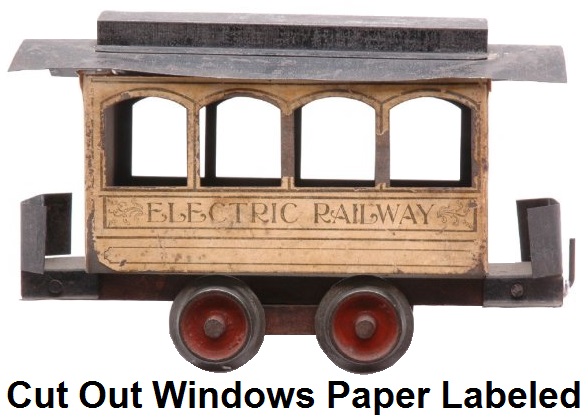
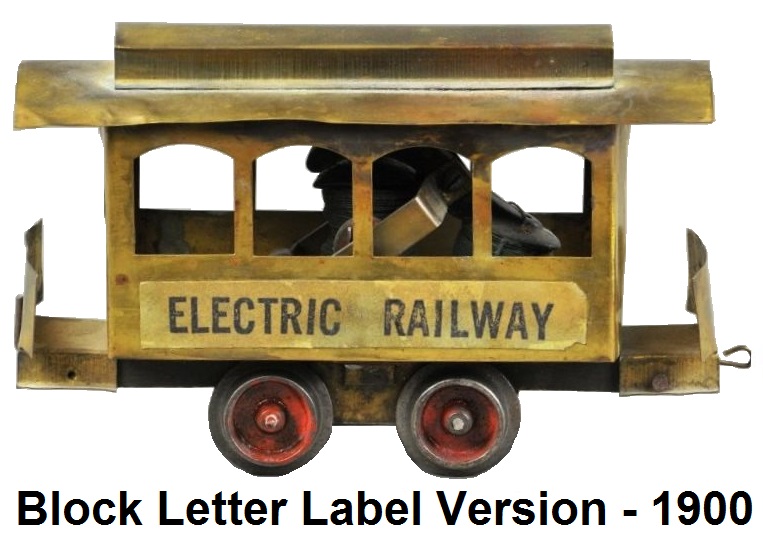
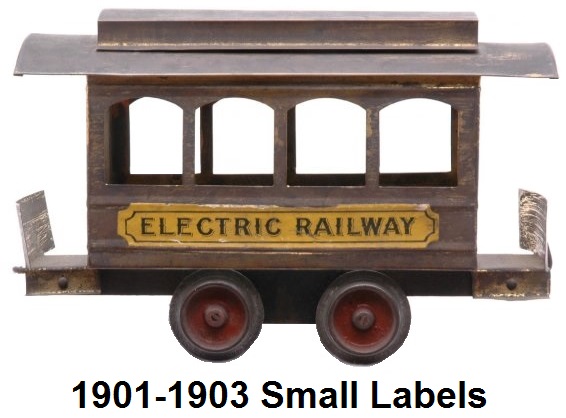
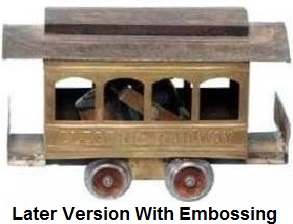
The first manufacturing facility was located at 5th & Elm Street, but because of the
limitations and logistics challenges with rewinding very large armatures presented by a second story operation,
the company was moved to larger ground level facilities at 830 West 6th Street in July of 1894.
The very first electric train products made were brass trolleys. Each powered unit was 7 inches long, 4½ inches
high with a single 4 wheel truck, and equipped with a 2 pole, non-reversing 10 volt electric motor.
It had 4 windows and cast iron wheels. The motor was mounted to the wood base inside the body. A
rubber band or string belt was used to connect the pulley on the motor armature shaft end to one of the
trolley wheels that was grooved.
The trolleys were available in both powered and unpowered (trailer) versions. Included with the set was
a 3 foot diameter circle of track. Priced at $3.50 and marketed as the #1 'Complete Electric Railway',
the set became very popular, especially around Christmas, and the company wound up producing 3 times
the amount of sets as originally planned. Between the years 1896 and 1897 approximately 4,500 of these
trolleys were made. Most of the trolleys were made out of brass with wood frames and had roofs that
were painted black. All of these early trolleys were made with large lithographed paper labels that
were glued onto the sides and ends of the trolley. All the trolleys had the words "Electric Railway"
on each side. In the early versions the windows were part of the litho and were covered over. In later
versions the windows were cut out from the paper and the tinplate, exposing the motor inside.
One variant of the #1 trolley used small labels that had large block lettering another variation
had smaller block letters on the paper label and framing on each side. The early trolleys had completely
smooth sides and ends to accomodate the paper labels. By 1900 3 corrugated lines
were embossed into the car sides, and by 1904 the 'Electric Railway' lettering itself was also
embossed. The #1 trolley remained in the line from 1896 through 1907.
The manufacturing company was incorporated in 1897 with Morten Carlisle as President
and Robert Finch as Secretary and Treasurer. And that year the first catalogue depicting trains was issued.
The next item to be made was the #2 eight wheel double motor 12 inch long trolley, or referred to by some
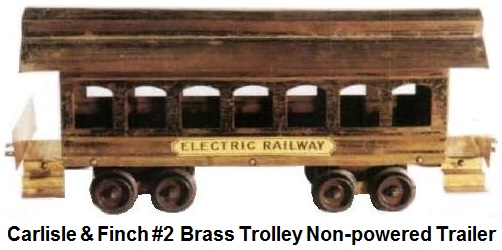 as an Interurban. The 1898 catalog lists two versions. One for operation on batteries and a similar one
for 110 volts DC or AC operation intended to be used as a store window dispiay. It was made of brass with
a wood floor, wood trucks and the wheels were cast iron. It featured the same two pole motors, one in each truck,
as the rubber band drive ones used in the #1 trolley. It was 5 inches high, had 7 windows, a smooth brass body,
open end platforms, rounded end brass celestory roof, and the paper label "Electric Railway" signs under the
windows on each car side. The initial price for the motorized trolley car was $5.00. A matching unpowered trailer
car was offered at $2.00. The trail car was equipped with link & pin type couplers. Despite changes to the
sides, labelling and couplers over time, the same illustration of this car was continued in every Carlisle & Finch
catalog from 1899 through 1915. However, the #2 trolley in this form was only offered through 1902.
as an Interurban. The 1898 catalog lists two versions. One for operation on batteries and a similar one
for 110 volts DC or AC operation intended to be used as a store window dispiay. It was made of brass with
a wood floor, wood trucks and the wheels were cast iron. It featured the same two pole motors, one in each truck,
as the rubber band drive ones used in the #1 trolley. It was 5 inches high, had 7 windows, a smooth brass body,
open end platforms, rounded end brass celestory roof, and the paper label "Electric Railway" signs under the
windows on each car side. The initial price for the motorized trolley car was $5.00. A matching unpowered trailer
car was offered at $2.00. The trail car was equipped with link & pin type couplers. Despite changes to the
sides, labelling and couplers over time, the same illustration of this car was continued in every Carlisle & Finch
catalog from 1899 through 1915. However, the #2 trolley in this form was only offered through 1902.
Catalogs were expanded in 1898 and production now included an entire line.
The #3 coal mining set was made up of the #3 0-4-0 loco and three small 4 wheel coal
cars. Initial versions of these coal cars were diecast on wood frames. Later versions used tin buckets
and could tilt sideways and dump their loads. The #3 mining loco was made of tin and intially used the same
2 pole motor and belt drive as the #1 and #2 trolleys. But beginning in 1899 the new geared 3 pole
armature motor and a reversing switch were installed. The #3 became a mainstay in the product line
for several years and became the least expensive product offered at $3.5O for a set. Early versions of the
locomotive used paper labels. Later versions were enameled, then eventually embossing was used and the style
of the loco changed from a trapezoidal shape to a more rounded humped design.


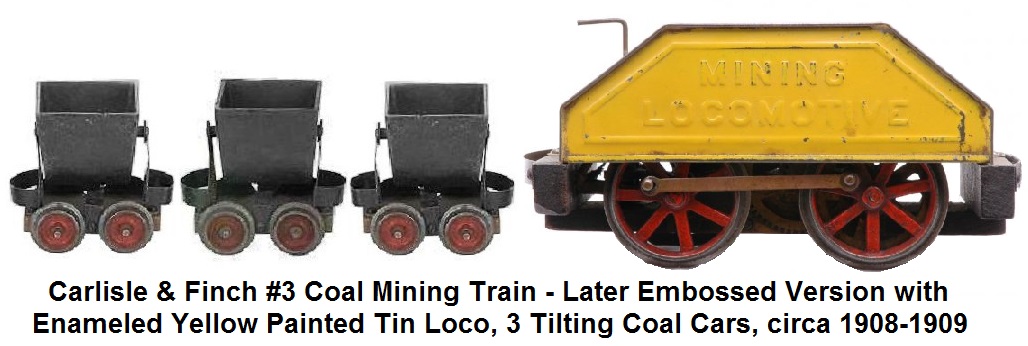

A fourth item listed in the early catalogs was the #4 'Inclined Plane Railway'. This item
is so rare that there are no known existing models today. This item apparently was not very popular, and
was discontinued in 1899 after manufacture of only 120 units. Carlisle & Finch also created a
#20 toy electric powered boat and the #19
toy electric powered automobile during this period. But, like the incline railway, these were not
popular items and manufacturing of these products was discontinued after very short runs. Carlisle
& Finch replaced the #4 incline railway with the very popular #4 0-4-0 steam type loco in 1899.
By assigning it the number 4, Carlisle & Finch was able to retain the numbering sequence in their catalogs.
The #4 Steam Freight train set proved to be another mainstay in the Carlisle & Finch Company line and
because of its economy, durability and popularity, thousands were produced. The #4 came in both passenger
and freight sets in 1899. By 1900 Carlisle & Finch had outgrown
its facilities and a move was made to a new location at 229-231 East Clifton Avenue in June.
This would be the company's home for the next 47 years.

The trains stood about 5.5
inches tall, were made of wood and metal, were colorful, and ran on metal track
with rails that were spaced two inches apart. Initial production of the electric train line #1 trolleys
used three rail track, then shortly after 1897, the track and trolleys were converted to two rail. These 3 rail
trolleys were produced in very limited quantities (500 made in 1896) and are considered to be very rare. There
are very few examples in existence today. Two rail became the standard for Carlisle & Finch.
Using one rail as a negative conduit for electricity and the other as a positive one had never met
with success until Carlisle & Finch perfected the concept. Carlisle & Finch trains
were heavy and highly detailed, and catered to the high end market. Early trains used lithographed paper labels
to supply the cars with details for numbering and livery. The use of wood frames reduced weight,
reduced costs, and helped absorb noise from the electric motors. In addition to using wood for the
underframe and cab floors, it was also used for the sand dome, head light, bell, pilot beam, boiler
front and boiler button on the locomotives. During this period brass was utilized to fabricate many items.
This period saw the use of a link and pin type coupler connected by iron staples. Four wheels
were simply nailed into a green painted wood block bolster which made it unnecessary to insulate
the cast iron wheels on the loco and cars.

With the release of the #4 locomotive several new manufacturing techniques
were put into production. Early Motorized units from Carlisle & Finch had employed belt or rubber band drive
mechanisms. In the #4, as the catalog described, the power was transmitted to the locomotive's
drive wheels via 'double reduction spur gearing with accurately cut teeth'. This was a set of brass gears,
very similar to the drive mechanisms found in clockwork toys and trains from this era. Another major improvement
was the introduction of a three pole armature based motor instead of the original two pole one. The first
version of the #4 was all black with paper labels covering the cab, and bore painted gold
boiler bands, window outline, the #683 under the cab windows, trim lines and L.S. & M.S.R.R. marking on
the tender sides. It was fitted with link and pin tye couplers. The #683 also appeared on the end
of the tender. The locomotive drive wheels were painted red and had 7 spokes. This version remained
in production through 1903. It was available in both a passenger
consist and a freight consist, although the frieght train had only the loco, tender, a yellow labeled
#12 boxcar and a red labelled #11 gondola. These were the first 2 freight cars produced by C&F.
 While Jehu Garlick was first to market an electrically powered
train with his limited run of 200 Electric Tunnel Locomotives in 1895, a year later Carlisle
& Finch was the first to market complete electric-powered train sets and thus were the earliest leader in
US toy train production through 1904. Lionel didn't produce their first electric
train until 1901 and Voltamp came out with theirs in 1903.
American Flyer's
first electric train came out in 1918. Carlisle & Finch was eventually overtaken in the toy train marketplace by
Ives Toy trains. Carlisle & Finch created an agent system for distribution of its toy
trains and trolleys. They would ship inventory to their agents who would sell them directly to the public.
Ohio Electric Works, based in Cleveland, was one of their best customers and issued C&F catalogues with
their own name on them. Carlisle & Finch also operated a direct mail order sale and repair business. In
1901 Carlisle & Finch grossed nearly $21,000 from the sales of toys.
While Jehu Garlick was first to market an electrically powered
train with his limited run of 200 Electric Tunnel Locomotives in 1895, a year later Carlisle
& Finch was the first to market complete electric-powered train sets and thus were the earliest leader in
US toy train production through 1904. Lionel didn't produce their first electric
train until 1901 and Voltamp came out with theirs in 1903.
American Flyer's
first electric train came out in 1918. Carlisle & Finch was eventually overtaken in the toy train marketplace by
Ives Toy trains. Carlisle & Finch created an agent system for distribution of its toy
trains and trolleys. They would ship inventory to their agents who would sell them directly to the public.
Ohio Electric Works, based in Cleveland, was one of their best customers and issued C&F catalogues with
their own name on them. Carlisle & Finch also operated a direct mail order sale and repair business. In
1901 Carlisle & Finch grossed nearly $21,000 from the sales of toys.
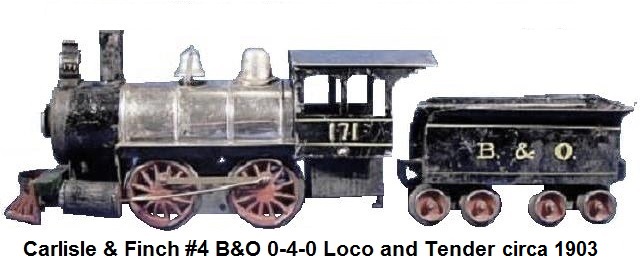 In 1903 Carlisle & Finch came out with an improved version of the #4 0-4-0 locomotive that had a
shiny nickel plated boiler, a cast iron oil type dummy headlight, a copper bell, a nickel sand dome and
boiler bands that were embossed right into the boiler. The loco cab featured arched top non-embossed
window openings with the #171 embossed under the windows, into the cab sides. The locomotive bore
the same red painted 7 spoke drivers as its predecessor. The wood underframe, boiler
front and 3 pole motor were the same as the original design. The new #4 locomotive and tender sold for $6.50.
By 1904 a new truck with detailed outside frames and stamped brass wheels using a red fiber washer for
insulation replaced the wood bolster type trucks on all cars, including freights and passenger
equipment. Other improvements in the line included the use of embossing on the tinplate, and
less use of lithographed paper labels, more handrail detail on the locomotives, and more prototypical
paint schemes. In late 1903 Carlisle & Finch switched over to bumper band type couplers. A later
version of the #4 loco produced in 1904 had newer flat drive wheels, still painted red, but now with
In 1903 Carlisle & Finch came out with an improved version of the #4 0-4-0 locomotive that had a
shiny nickel plated boiler, a cast iron oil type dummy headlight, a copper bell, a nickel sand dome and
boiler bands that were embossed right into the boiler. The loco cab featured arched top non-embossed
window openings with the #171 embossed under the windows, into the cab sides. The locomotive bore
the same red painted 7 spoke drivers as its predecessor. The wood underframe, boiler
front and 3 pole motor were the same as the original design. The new #4 locomotive and tender sold for $6.50.
By 1904 a new truck with detailed outside frames and stamped brass wheels using a red fiber washer for
insulation replaced the wood bolster type trucks on all cars, including freights and passenger
equipment. Other improvements in the line included the use of embossing on the tinplate, and
less use of lithographed paper labels, more handrail detail on the locomotives, and more prototypical
paint schemes. In late 1903 Carlisle & Finch switched over to bumper band type couplers. A later
version of the #4 loco produced in 1904 had newer flat drive wheels, still painted red, but now with
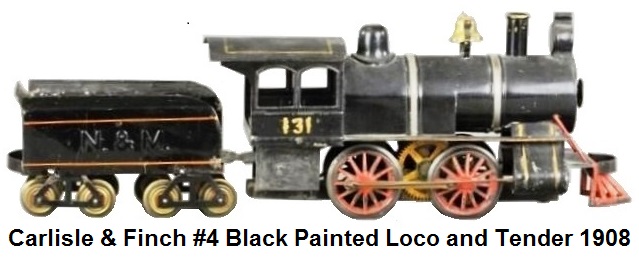 12 narrow spokes. By 1907 a 3rd version of the #4 was now being made. It was modernized with embossing
around the cab windows, and with embossing stripes and the #131 under the windows. The tender for this model
came with the new outside truck frames, replacing the old wood bolsters. The stamped brass wheels were
insulated with the red fiber washer. The tender was embossed with N & M on each side. Later tenders had a double
row of rivets along the top and down the front on each side. The design of the cylinders changed in
that they were no longer slung independently from the boiler, but extended from the boiler sides. Handrails
were added along each side of the boiler and diagonal braces placed from the pilot beam to the boiler
sides. The fourth and final version of the #4 abandoned nickel plating and was painted all in black.
This model had separate boiler bands, metal boiler front, orange trim, and the box type tender with rivets.
It also had square cab windows, drum type headlight, and other variations such as short or high
dome or smoke stack.
12 narrow spokes. By 1907 a 3rd version of the #4 was now being made. It was modernized with embossing
around the cab windows, and with embossing stripes and the #131 under the windows. The tender for this model
came with the new outside truck frames, replacing the old wood bolsters. The stamped brass wheels were
insulated with the red fiber washer. The tender was embossed with N & M on each side. Later tenders had a double
row of rivets along the top and down the front on each side. The design of the cylinders changed in
that they were no longer slung independently from the boiler, but extended from the boiler sides. Handrails
were added along each side of the boiler and diagonal braces placed from the pilot beam to the boiler
sides. The fourth and final version of the #4 abandoned nickel plating and was painted all in black.
This model had separate boiler bands, metal boiler front, orange trim, and the box type tender with rivets.
It also had square cab windows, drum type headlight, and other variations such as short or high
dome or smoke stack.
In 1903 an entirely new #2 all brass interurban trolley, now with 10 windows was produced,
replacing the 7 window 12 inch model. The new #2 was the largest trolley ever made by Carlisle & Finch.
It was 19 inches long and was outfitted with a new larger motor and cast brass side frames for the trucks.
This basic model remained in the line through 1915 with a few changes over time. Initially priced at $5.75,
the cost came down to $4.25 in 1913. In 1907 and 1908, unpainted nickel finish tinplate was substituted for
brass in the body and roof of the 10-window #2 Interurban. In addition, in 1908 embossed edges were added
around the 10 windows. By 1909 a switch was made back to a brass body, but now the #2 trolley had 5 large windows
instead of 10 smaller ones, similar to the #87 pullman that was offered in 1905.
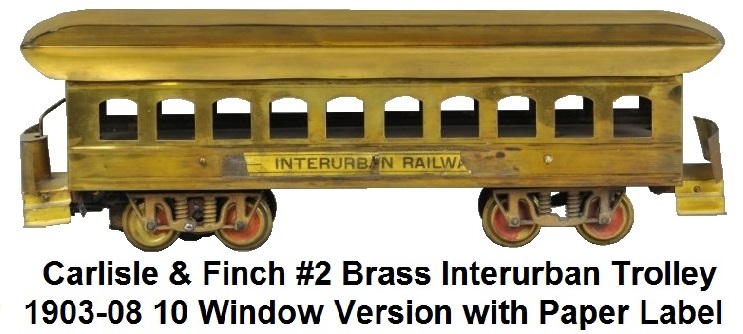
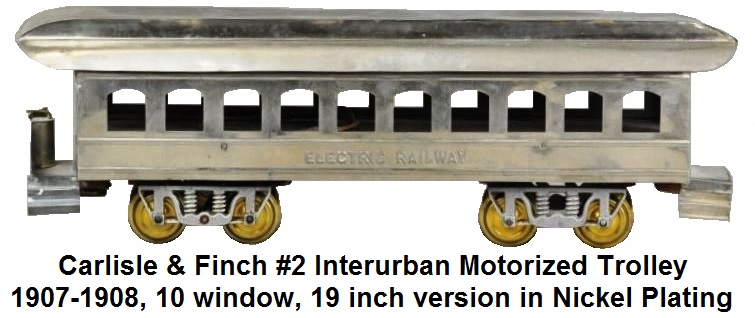
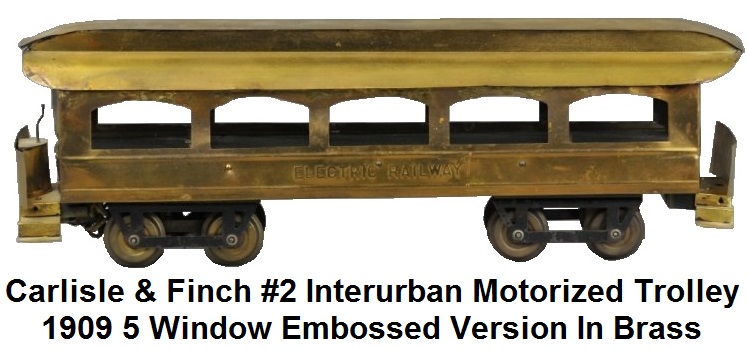
 This second period of development included the creation of the large #2 interurban as well
as the creative #53 motorized derrick car, the #87 passenger car and the #45 loco. The largest, most
luxurious deluxe steam type locomotive ever made by Carlisle & Finch was the 4-4-2
#45 in 1904. Catalogues stated that it was "made exactly according to scale and no pains were spared to
make it complete as to workmanship and finish". It measured 27½ inches long (loco and tender) and required a minimum
track radius of 30 inches to operate, at a rating of 10 volts (36 inch radius was recommended). #45 was
powerful having a DC motor with a "Gramme ring" or fly-wheel type armature with a five segment
commutator. Gearing was high, so the resulting ride was smooth and operation was relatively silent.
Stops were gentle when track power was shut off. It was also the most expensive loco selling for $17.00
in 1906, for just the locomotive. It weighed 13 pounds. For $20, 36 feet of track with ties and 9 dry
cell batteries were included. This version continued in the line from 1904 to 1908. By 1909 the three
pole electric motor was substituted in the #45. One feature that never varied on all Carlisle & Finch
locomotives was the red painted drive wheels.
This second period of development included the creation of the large #2 interurban as well
as the creative #53 motorized derrick car, the #87 passenger car and the #45 loco. The largest, most
luxurious deluxe steam type locomotive ever made by Carlisle & Finch was the 4-4-2
#45 in 1904. Catalogues stated that it was "made exactly according to scale and no pains were spared to
make it complete as to workmanship and finish". It measured 27½ inches long (loco and tender) and required a minimum
track radius of 30 inches to operate, at a rating of 10 volts (36 inch radius was recommended). #45 was
powerful having a DC motor with a "Gramme ring" or fly-wheel type armature with a five segment
commutator. Gearing was high, so the resulting ride was smooth and operation was relatively silent.
Stops were gentle when track power was shut off. It was also the most expensive loco selling for $17.00
in 1906, for just the locomotive. It weighed 13 pounds. For $20, 36 feet of track with ties and 9 dry
cell batteries were included. This version continued in the line from 1904 to 1908. By 1909 the three
pole electric motor was substituted in the #45. One feature that never varied on all Carlisle & Finch
locomotives was the red painted drive wheels.

Carlisle & Finch and later Howard developed the concept of a
train outfit which included the trains or trolleys, track, and a station and/or bridges so that a hobbyist
could set up a layout right out of the box. The #88 Railway was Carlisle & Finch's most elegent complete
train set. It was composed of
the #45 locomotive and tender, #51 baggage car, and Two #52 passenger cars. In 1906, it sold for $34.00. This set
is considered by collectors to be the most perfectly proportioned model train ever produced. The #52 passenger car,
at 19 inches long and six inches high above the rails was the largest ever manufactured. It was made of polished
brass. Carlisle & Finch produced four styles or sizes of passenger cars. The smallest size was the #13 coach and #13B

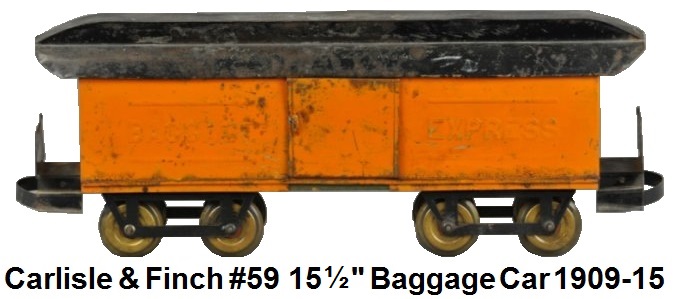 baggage car at 12 inches long. The early baggage car came with yellow lithographed paper labels covering
all sides, bearing Union Pacific R.R. livery and 'Baggage Express', and a black painted roof. The later
versions were painted with orange enamel and embossed with the number 26 and 'Baggage Express'. These cars featured
sliding doors on each side. The #13 coaches were made of brass and had paper labels with
'Electric Railway' on the sides of the early versions. This car was essentially the same as the first version
of the #2 non-powered trolley trailer car issued in 1899. Later versions were embossed and some were
made of Nickel plate. Early versions of these 12" coaches and baggage express cars were equipped with
the link and pin type couplers. Later The #60 passenger and #59 baggage cars were 15½ inches long
(normally packaged with the #34 loco). The #52 pullman passenger and #51 baggage cars were 19 inches long and
were designed to be pulled by the #45 loco. The 19" pullman passenger car utilized the same 10 window brass body
as the #2 trolley, but came with a black painted tin roof. The rarest of all passenger cars was
the #87 Pullman Sleeping Car with cast iron wheels and six wheel trucks, measuring 18 inches long.
baggage car at 12 inches long. The early baggage car came with yellow lithographed paper labels covering
all sides, bearing Union Pacific R.R. livery and 'Baggage Express', and a black painted roof. The later
versions were painted with orange enamel and embossed with the number 26 and 'Baggage Express'. These cars featured
sliding doors on each side. The #13 coaches were made of brass and had paper labels with
'Electric Railway' on the sides of the early versions. This car was essentially the same as the first version
of the #2 non-powered trolley trailer car issued in 1899. Later versions were embossed and some were
made of Nickel plate. Early versions of these 12" coaches and baggage express cars were equipped with
the link and pin type couplers. Later The #60 passenger and #59 baggage cars were 15½ inches long
(normally packaged with the #34 loco). The #52 pullman passenger and #51 baggage cars were 19 inches long and
were designed to be pulled by the #45 loco. The 19" pullman passenger car utilized the same 10 window brass body
as the #2 trolley, but came with a black painted tin roof. The rarest of all passenger cars was
the #87 Pullman Sleeping Car with cast iron wheels and six wheel trucks, measuring 18 inches long.
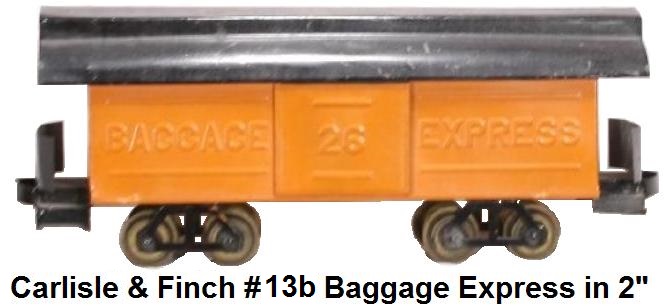
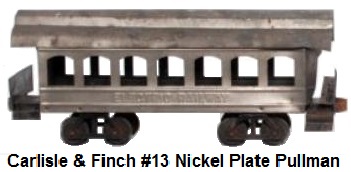
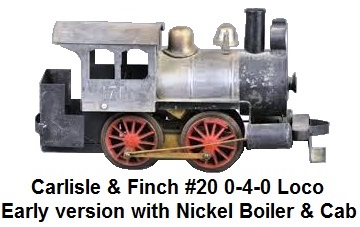
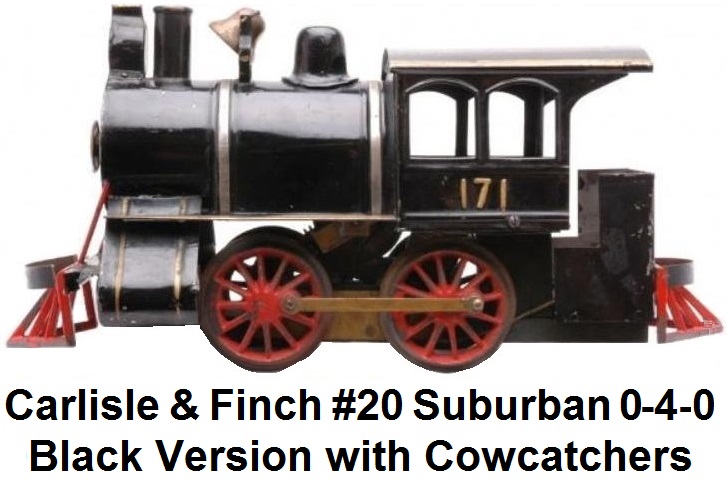 In addition to the #4, 0-4-0, Carlisle & Finch also made a smaller #20 0-4-0 switching engine with a coal bunker
referred to as a Suburban. This locomotive was 13 inches in length and featured a brass bell. It was carried
in thre line from 1903 to 1907.
Also during this period newer trolley models were introduced. These included a #42 Electric
Railway that consisted of a 5 window brass trolley and non-powered trailer car. This version featured the
newer 3 pole reversing motor and brass spur gearing. It operated at a 4 to 5 volt range and could be acquired
in a set with 9 feet of strip steel 2" track and 4 dry cell batteries for $3.35. In 1905 through 1908, the
#42 trolley was also offered with an elevated railway system, catalogued as #98, with the track mounted
on 10 inch high cast iron posts. This trolley was slightly taller than the #1 trolley but looked similar.
The motor truck was identical to the motor truck found on the #2 Interurban trolley. The trailer was dropped by
1911, but the trolley remained available through the catalogue through 1915. 1904 also saw the release of
the #18 4-wheel trolley. The #18 was a 13½ inch long by 6 inch high closed trolley car with a polished brass body,
brass open end platforms, four very wide windows and a black painted tinplate roof. It was priced at $4.50 and
remained in the catalogue through 1913.
Another powered unit produced starting in 1904 was the #19 Summer Trolley. It was 14¾ inches long,
6 inches high, was constructed of brass and had 4 wheels. It's interior bench seats were reversible.
Some versions were painted in yellow and orange. The roof was always
unpainted polished brass. It was priced at $5.50 and appeared in the catalogue through 1911. Both the
#18 and #19 trolleys were equipped with the improved 3 pole motors located entirely beneath the wooden
floors. No trailers were offered with either of these powered trolley cars. In 1905 and 1906 these two
cars were also offered as #99 and #100, respectively, equipped with working trolley poles for operation
under overhead wires. The closed car with trolley pole was priced at $5.25 and the open car at $6.25.
Carlisle & Finch also offered the #103 cast iron wire bracket poles for building the overhead wire system.
In addition to the #4, 0-4-0, Carlisle & Finch also made a smaller #20 0-4-0 switching engine with a coal bunker
referred to as a Suburban. This locomotive was 13 inches in length and featured a brass bell. It was carried
in thre line from 1903 to 1907.
Also during this period newer trolley models were introduced. These included a #42 Electric
Railway that consisted of a 5 window brass trolley and non-powered trailer car. This version featured the
newer 3 pole reversing motor and brass spur gearing. It operated at a 4 to 5 volt range and could be acquired
in a set with 9 feet of strip steel 2" track and 4 dry cell batteries for $3.35. In 1905 through 1908, the
#42 trolley was also offered with an elevated railway system, catalogued as #98, with the track mounted
on 10 inch high cast iron posts. This trolley was slightly taller than the #1 trolley but looked similar.
The motor truck was identical to the motor truck found on the #2 Interurban trolley. The trailer was dropped by
1911, but the trolley remained available through the catalogue through 1915. 1904 also saw the release of
the #18 4-wheel trolley. The #18 was a 13½ inch long by 6 inch high closed trolley car with a polished brass body,
brass open end platforms, four very wide windows and a black painted tinplate roof. It was priced at $4.50 and
remained in the catalogue through 1913.
Another powered unit produced starting in 1904 was the #19 Summer Trolley. It was 14¾ inches long,
6 inches high, was constructed of brass and had 4 wheels. It's interior bench seats were reversible.
Some versions were painted in yellow and orange. The roof was always
unpainted polished brass. It was priced at $5.50 and appeared in the catalogue through 1911. Both the
#18 and #19 trolleys were equipped with the improved 3 pole motors located entirely beneath the wooden
floors. No trailers were offered with either of these powered trolley cars. In 1905 and 1906 these two
cars were also offered as #99 and #100, respectively, equipped with working trolley poles for operation
under overhead wires. The closed car with trolley pole was priced at $5.25 and the open car at $6.25.
Carlisle & Finch also offered the #103 cast iron wire bracket poles for building the overhead wire system.
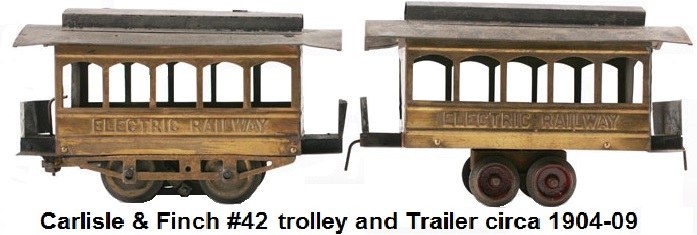
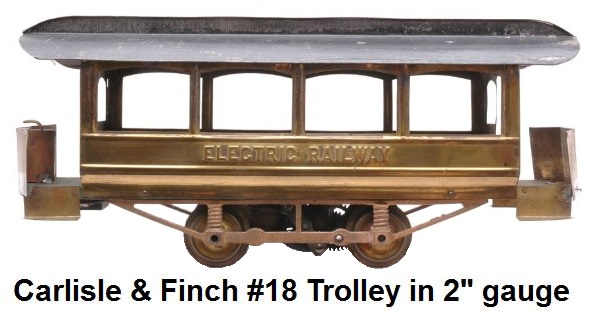
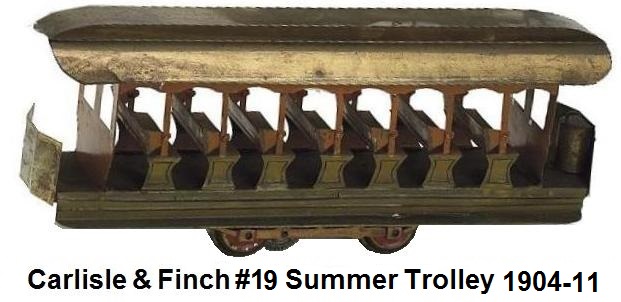
Two inch gauge 2 rail electric trains require a DC power source.
Carlisle & Finch trains were initially powered using wet cell batteries. This approach created challenges
for the hobbyists because these batteries were not commercially available, so they had to assemble the
carbon and zinc strips and mix the chromite wet cell elements themselves, usually employing glass
Ball-type jelly jars. Carlisle & Finch supplied these mercury coated zinc and carbon strips attached to
a wood cross piece and this assembly could be placed into glass tumblers filled with a mixture of bichromate
of potash and sulfuric acid, that could be wired into a series to generate the needed electrical current.
In 1902, Carlisle & Finch introduced dry cell batteries to make running their
trains easier. Later on, they introduced several other clever dynamo and hand cranked mechanisms for
generating the electrical current to run the trains. In those days, few homes had electrical power,
so these methods (batteries, dynamos, etc.) had to be provided. One very clever electric current
generator that Carlisle & Finch introduced actually utilized a water turbine, propelled by a garden hose.
It could generate direct current capacity of 75 watts and sold in great numbers.
Eventually in 1907, they came out with transformer type devices that utilized household current.

 A third period of development saw less reliance on the use of brass for component
construction with tin and steel emerging as the dominant material used in most freight cars and locomotives.
Some passenger cars were made using nickel plating. Items were painted in enamel, and road names were embossed
into the metal.
In 1908 Carlisle & Finch felt the need to bridge the gap between their small 0-4-0 #4
and #20 steam outline locomotives and the big 4-4-2 #45. They released the #34 Atlantic type. This model used the
same 4-4-2 wheel arrangement as the #45 but was shorter at 23 inches (loco & tender). It was fitted with
the same three pole self starting reversing motor with double reduction gearing. The iron driving wheels were
the same size as the #45 at a 2 9/16 inch diameter, but smaller stamped brass pilot wheels were used.
It was designed to operate on track with an 18 inch radius. Both the front and rear trucks were swiveled.
It had a nickel boiler and cab embossed roadname (B&O or P.R.R.), black chassis, wood frame,
red painted cast iron pilot and drivers, and #131 embossed 8 wheel tender with black painted sheet metal and orange
striping. While the first models were nickel with a black boiler front, the Later models were painted all
black. It weighed 8 pounds and was priced at $11. At this point in time one-third of the company's revenue was
generated through the sales from the electric trains and toys.
A third period of development saw less reliance on the use of brass for component
construction with tin and steel emerging as the dominant material used in most freight cars and locomotives.
Some passenger cars were made using nickel plating. Items were painted in enamel, and road names were embossed
into the metal.
In 1908 Carlisle & Finch felt the need to bridge the gap between their small 0-4-0 #4
and #20 steam outline locomotives and the big 4-4-2 #45. They released the #34 Atlantic type. This model used the
same 4-4-2 wheel arrangement as the #45 but was shorter at 23 inches (loco & tender). It was fitted with
the same three pole self starting reversing motor with double reduction gearing. The iron driving wheels were
the same size as the #45 at a 2 9/16 inch diameter, but smaller stamped brass pilot wheels were used.
It was designed to operate on track with an 18 inch radius. Both the front and rear trucks were swiveled.
It had a nickel boiler and cab embossed roadname (B&O or P.R.R.), black chassis, wood frame,
red painted cast iron pilot and drivers, and #131 embossed 8 wheel tender with black painted sheet metal and orange
striping. While the first models were nickel with a black boiler front, the Later models were painted all
black. It weighed 8 pounds and was priced at $11. At this point in time one-third of the company's revenue was
generated through the sales from the electric trains and toys.
Freight cars came in two sizes. The more common regular size, and a large,
13½ inch size long gondola, box car, and caboose.
Smaller more Common size Carlisle & Finch Freight Cars
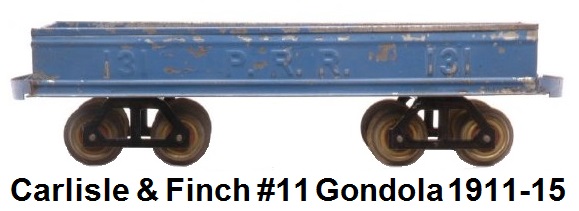
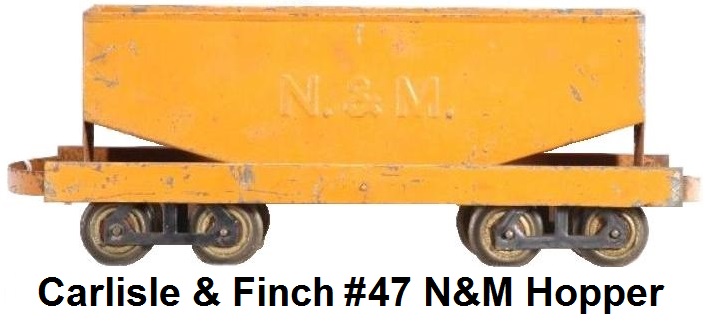
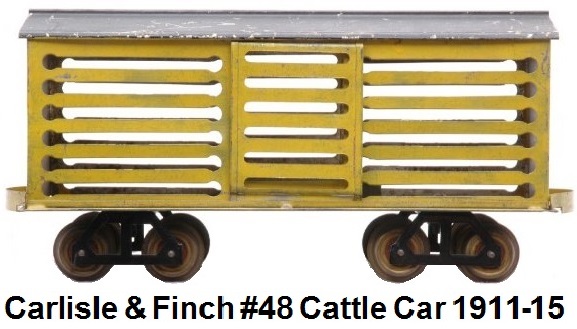
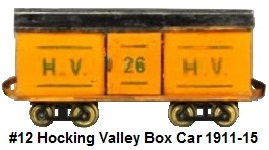
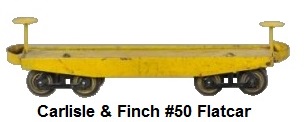
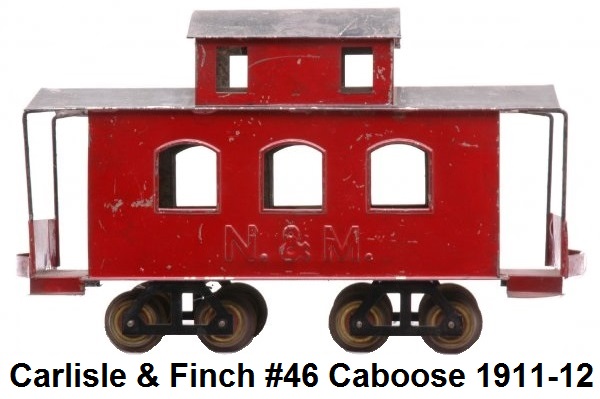
Larger 13½ inch size Carlisle & Finch Freight Cars
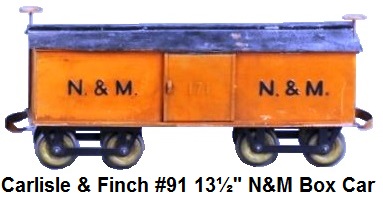
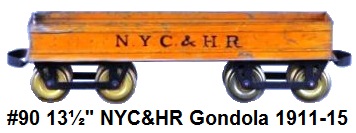
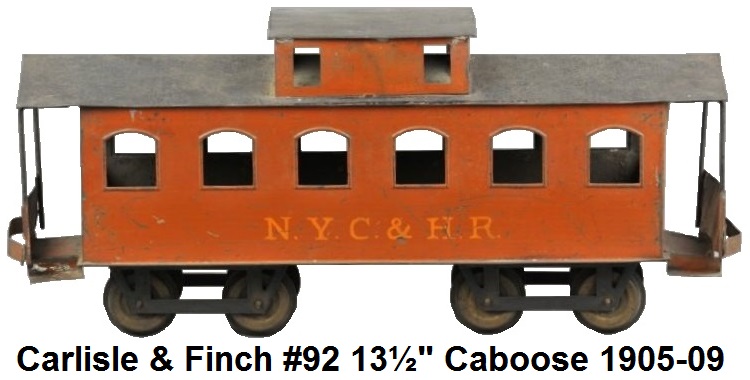
Three other smaller, short-lived U.S. manufacturers, Knapp,
Howard, and Voltamp,
adopted Carlisle & Finch's 2-inch 2 rail track design. However, Carlisle & Finch did not intially make
sectional type track, while the others did. Carlisle & Finch's early approach was to supply long
thin metal rail strips and slotted wooden ties, so the hobbyist had to assemble his track in much
the same way that real railroaders built their trackage. It was thought that by having
longer sections of track, the electrical current would
be stronger throughout the layout. Eventually various kinds of 'T' rail track were made as well as
switches, cross-overs and track end bumpers.
Carlisle & Finch's offerings were by definition non-standard,
even though they were considered to be the inventors of the electric train.


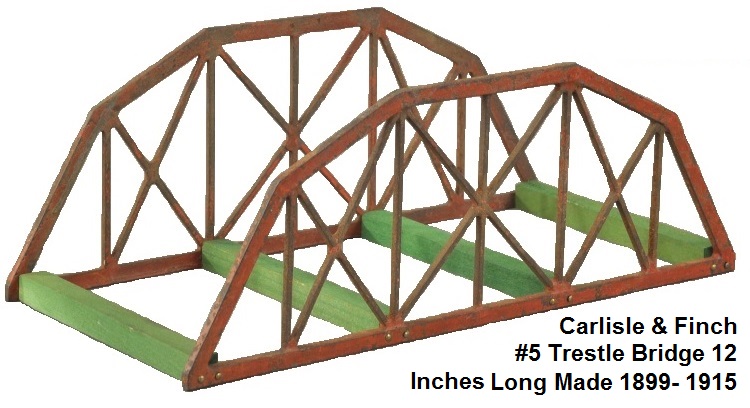
The numbers appearing on Carlisle & Finch locos and cars do not coincide with catalogue
numbers. The number '131' appears on the later #4 loco cab, on the #4 loco tender and on the #11 gondola.
The number '171' appears on the #20 Switcher cab, on the #91 box car and on the middle nickel #4 locomotive.
The number '82' appears on the cab of the famous #45 Locomotive. The number '26' appears on the #13b
Express Baggage car and on the #12 Box car. The number '111' appears embossed on the #51 Baggage express
car. Carlisle & Finch also made accessories such as the #9 Buffalo Railway Station with Automatic
Signal, the #97 Passenger Terminal, the #96 Freight Depot, and several trestles and bridges including
the #57 Die-cast Suspension Bridge that was 36 inches long.
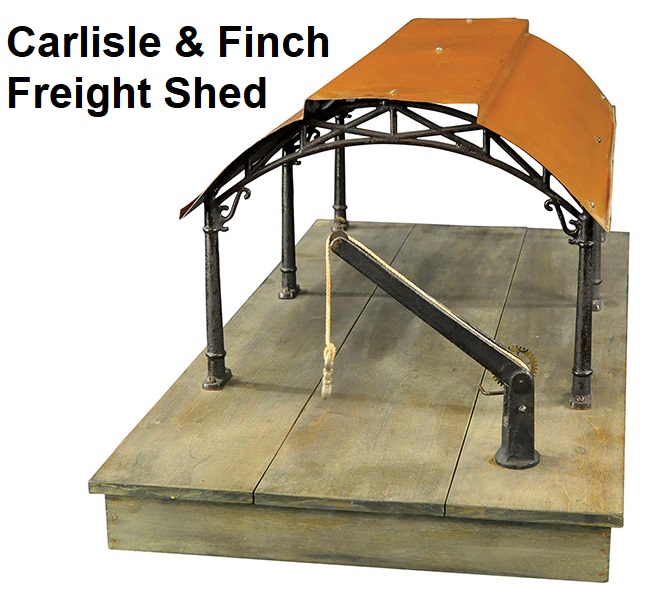 At the height of train production, Carlisle & Finch employed about 120 workers.
Carlisle & Finch issued its first catalogue depicting trains in 1898, and its
final catalogue for trains was created in 1915. 1916 catalogues were re-issues of the 1915 catalogues.
At the beginning of World War I, the United States Government ordered Carlisle and
Finch to cease toy
train production in order to concentrate on producing searchlights for the U.S. Navy and United States
Coast Guard. At the end of the war, the company did not resume toy train production, choosing
instead to concentrate on its profitable searchlight business. Within a decade, it was the
largest producer of military searchlights in the country.
At the height of train production, Carlisle & Finch employed about 120 workers.
Carlisle & Finch issued its first catalogue depicting trains in 1898, and its
final catalogue for trains was created in 1915. 1916 catalogues were re-issues of the 1915 catalogues.
At the beginning of World War I, the United States Government ordered Carlisle and
Finch to cease toy
train production in order to concentrate on producing searchlights for the U.S. Navy and United States
Coast Guard. At the end of the war, the company did not resume toy train production, choosing
instead to concentrate on its profitable searchlight business. Within a decade, it was the
largest producer of military searchlights in the country.
Finch bought out Carlisle's share of the company in 1926. At that time Brent S. Finch
the son of Robert S. Finch was made President and Robert S. Finch continued as Secretary and Treasurer.
Over the ensuing decades, the company began producing equipment for civilian use, with its searchlights
being used in lighthouses and on offshore oil rigs. An attempt was made to resurrect the train line in
the 1930's. Several cast aluminum trains and a streamliner sample were developed. However manufacture
of these products was never undertaken. This 100+ year-old company still exists today and continues
to produce its line of searchlights and beacons.
Carlisle & Finch trains from the early 20th century are very rare today and are highly
sought after by serious train and toy collectors. A very early #1 Carlisle & Finch trolley circa 1897 formerly
in the collection of noted train collector and Disney Animator Ward Kimball realized $8,050 in a November 2013
auction. A Carlisle & Finch Electric Railway #2 Interurban with a brass body and embossed sides commanded $12,980 at
the same 2013 auction. It had been entered in the sale with a $3,500-$4,500 estimate. Another Carlisle & Finch rarity,
a cast-iron #57 2-track suspension bridge with wood planking and metal slat tracks, estimated at $3,000-$3,500,
sold for $11,200. And at the same 2013 auction, a Carlisle & Finch Freight Set with a #131 locomotive, N. & M.
tender, #26 H.V. orange Box car, #131 blue P.R.R. gondola, maroon N. & M. Caboose, and a quantity of rail and wood
ties, all in original condition sold for $6,490. A circa 1904-08 Carlisle & Finch train set with a #45 loco, tender,
2 passenger cars and a baggage car sold for $46,020 at a 2014 Bertoia Spring Toy Train auction in Vineland, NJ.
At that same auction a boxed Carlisle & Finch freight set from the collection of Frank Loveland sold for $23,600.
In 2016, an original Carlisle & Finch freight shed with a tiered roof supported by six cast-iron columns with ornate
arch extensions sold for $23,600. At the 2016 Bertoia auction of Jerry & Nina Greene's collection of toy trains and
accessories, a scarce Carlisle & Finch #19 Summer trolley painted yellow and orange sold for $5,700.

Carlisle & Finch website
Back To Top of Page

